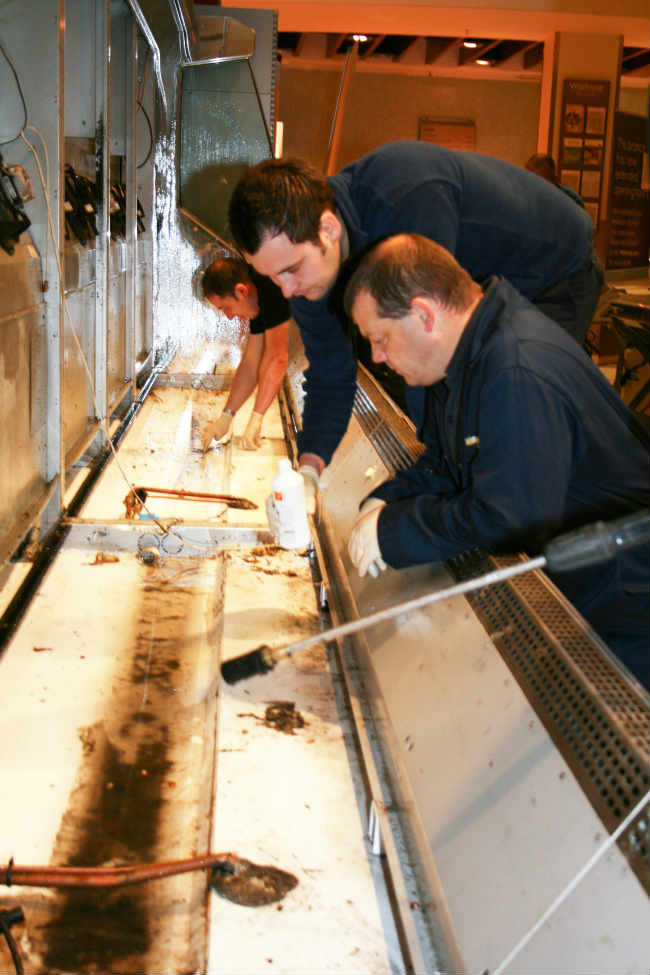10 May 2017
|
| Advanced Engineering chairman Barry Lea explains how a partnership with the University of Surrey has transformed refrigeration cabinet and chiller maintenance at supermarkets across the UK. If you’ve had the pleasure of doing a deep clean on a food chiller cabinet, you’ll no doubt be intimately familiar with the unpleasant sights awaiting you underneath the base plate, drain, and condensate tray. |
A THREE-STEP SOLUTIONIf you really want to be rid of the germs and stop them from becoming permanent houseguests there are three steps to go through: Stage 1: CLEAN. First, get the localised exopolysaccharide jelly out of the drains with a wet/dry vacuum. Then apply a powerful drain unblocker, like DrainSafe, to break down the exopolysaccharide further down the pipework by hydrolysis ensuring that you have free flowing drains. DrainSafe has been specially formulated for this purpose and is safe to use around food. Stage 2: KILL Stage two involves the use of a coil cleaner and disinfectant such as CoolSafe, an effective coil cleaner designed to remove all common contaminants left by organic materials on cooling coils, including slime, mould and foodstuffs. Not only that, CoolSafe will kill any microbes that it comes into contact with. Spray CoolSafe over the coil and in and around the drip tray and leave for 5-10 minutes, then rinse thoroughly. Stage 3: PROTECT Put ongoing protection in the condensate tray to treat the run-off on its way to the drain — keeping the drain clean too. |
With a good supply of moisture and food at hand, mould, algae, and bacteria are right at home in the condensate tray. It’s the perfect breeding ground for these little horrors as they grow and multiply and excrete a thick, protective exopolysaccharide — the slime or jelly you find in a problem cabinet.
We sent samples of slime from a range of store cabinets for independent laboratory analysis, and found that a single millilitre contained as much as ten million microbes. While it’s true that some of the germs were relatively harmless, others had the potential to cause serious infections. Worryingly, there were strains like Staphylococcus that are well-known for their immunity to biocides. And this is in close proximity to the food and has direct air current circulating over the top of it, this air then goes into the cabinet and out into the store. And if that wasn’t bad enough, microbial growth in the condensate tray leads to an even more pressing matter for retailers. The true cost of condensate leaks The exopolysaccharide jelly can often block the condensate drain. With nowhere to go, the water level rises… and that’s when the problems really start:
This seemingly minor problem of microbes growing in condensate trays between regularly scheduled cleaning is costing UK retailers millions of pounds per year, and that’s still a conservative estimate. So why does it keep coming back? No matter how thoroughly you clean a problem cabinet with a conventional pressure washer, the exopolysaccharide jelly will keep coming back again and again. By the time you return for your next scheduled clean six, nine, or twelve months later, it’s there again… unless you’ve been called out to a breakdown in the meantime. It’s simple: the micro-organisms form a exopolysaccharide biofilm , which protects them from the environment and makes them resistant to most conventional cleaning methods. And this film isn’t water soluble, so — even if you’ve removed the bulk of it, and the tray appears clean — there’ll still be a thin microbial layer left behind. And that spells disaster. The jelly causing microbes will have happily started growing back before you’ve even replaced the base plate. Advanced already had excellent solutions for the first two stages, the problem was we’d still been looking for a way that retailers could deal with that third stage: protection. We knew we needed a long-lasting product with the right surfactants and biocides to stop the microbes growing back, for up to a year — and that’s not an easy ask. So we turned to our Knowledge Transfer Partnership with the University of Surrey Chemistry Department, and Chartered Scientist chemist Dr Kajally Jobe — who has since joined us permanently as Advanced’s new Head of Research and Development. After months of hard work, he formulated a small, pink strip that works wonders. In fact, we were so impressed with this “magic bullet” that we named it after him. Formulated specifically for long-lasting antimicrobial protection in refrigeration units, they are designed with active agents called QUATS which cause cellular disruption in the membranes of micro-organisms. Jally Strips work synergistically with CoolSafe to offer superior cleaning and disinfecting performance. And the cost of this crucial final stage in the cleaning process, with the potential to solve a multi-million-pound maintenance problem? £1.20 per strip. Not content with stopping there, our KTP partnership has also brought us VerteX, an adaptive pH 7.6 cleaner for condensers and evaporators. A full-spectrum cleaner, its unique formulation allows it to change its own pH balance to either Acid or Alkali to better combat the soils it comes into contact with. Advanced’s three-step process is now in use nationwide and are already protecting tens of thousands of chiller cabinets, across three major supermarket brands. The results have been impressive: engineer callouts down by thousands, visibly cleaner cabinets, and a dramatic reduction in time lost stocking and restocking are measurable year-on-year. If you’re facing a problem with persistent microbial growth in a chiller cabinet, call Advanced Engineering on 01256 460300 |
Content continues after advertisements








